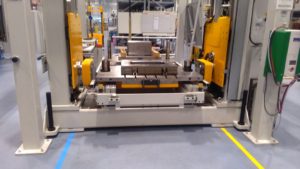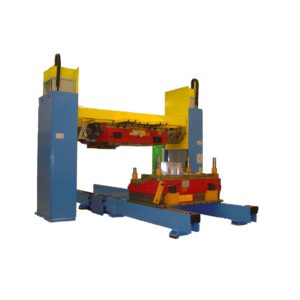Splitting dies
With care and precision
In the production industry, efficiency can not be high enough. And that goes for the care we give to our – often expensive – tools as well. The go-to partner for the subject of quick changeovers as well as complete and extensive care programs for dies and molds is EAS change systems. With a wide range of lifters, cars, inspection units, pre-heaters, splitters; the line of equipment expands ever further. The die splitters have recently been acknowledged by two large orders for mayor manufacturing companies.
Vincent Nijzink is CEO at EAS change systems and elaborates on the newest addition to the program of equipment that help reduce changeover times with increased safety. “In collaboration with a Belgium partner, we engineered a series of die splitters that is a versatile as the product itself. The splitters enable safe and quick maintenance on press dies and at the same time allow for maximal personal safety for the operators. The splitters open a die, turn on half over and thus allow for easy inspections and maintenance.”
For a big airplane manufacturer, EAS designed a 30 ton die splitter with cart and hydraulic tilting table. Safety scanners monitor the surrounding area of the cart while it is in motion. A hydraulic docking feature ensures correct alignment on the splitter table. The operation of the splitter is controlled with an HMI, allowing for maximum control.
The other large order concerns a 40 ton splitter that is programmed to handle as much as 110 different molds.
Safe and smart
“The splitters are available in many different designs, depending on the size and weight of the die as well as which steps the customer wants to execute during maintenance of the press dies. For the lighter dies we have engineered a one column design. This takes up only a small footprint, on the floor as well as economic and environmental. Thanks to our experience engineering, we are able to improve all of these aspects with everything we design. They know just how to make a design safe, cost-effective and smart. And in that specific order.”
Tighter safety regulations are one of the important reasons maintenance departments want to use specialized equipment to inspect and repair dies. But a well-kept die has a much longer lifespan and automated changeover procedures add to the cost aspect by reducing changeover times and thus saving large amount of money. Dies can be split and turned over in under two minutes with maximum safety for the operators. The splitter only needs one operator to control all tasks that are carried out as automated as the situation requires.
One or two columns
For the smaller dies, the splitter is engineered with a one-column design. It can handle dies weighing up to one ton. A two-column design can handle dies up to sixty tons and up. The die is positioned on the splitter by use of an overhead crane or forklift. The die is then automatically moved to the center of the splitter where the top platen of the die is lifted off of the bottom platen. The top platen is turned and placed next to the bottom platen. Each platen can be moved to any desired position on the unit, allowing access for inspection and maintenance. All movements are driven by hydraulic power units and the splitter can be equipped to accommodate dies of different dimensions.
Nijzink: “The splitter units are the ideal equipment for testing and spotting dies. The up and down movement of the upper platen is driven through two ball bearing screws connected by two gear motors with two encoders for perfect synchronization. The upper cross member can be rotated by 180°. The hydraulic power unit drives the rotation of the upper cross member and provides the power for the lower platen to slide out of the machinery. The parallels with T-slots for die clamping of upper and lower tooling can be moved to install dies of different dimensions. These parallels move easy on the ball bearings supports. The splitter can not only be used for maintenance and repair, but also for testing the mechanical operation of a tool or changing dies with the shortest possible changeover time.
Ever more automation
Nijzink: “The “splitter program has a wide range of standard units, but – as with all of our equipment – can easily be made to fit the specific needs of any logistic set up in any factory. Most of the systems we supply are integrated to cooperate with existing facilities, so called brown field installation. There is no need to replace other machinery, we are used to install our solutions as an add-on. The same goes for our clamping systems, our tool change tables and cars, inspection units, ejector couplers and any other changeover solution we engineer.”
According to Nijzink, in the present situation more and more companies are focusing on shortening lead time. “Not only do we need less personnel working in close proximity of each other, but automation allows us to be competitive in production. We see tools being equipped with RIFD chips that store valuable cycle data. Control systems for the automated change systems is already often being integrated in the machine control. And we are seeing robots changing tools with AGV’s, self-driven change tables, bringing the right tool to the right machine at the right time. Pre-heated if needed. Thanks to the RFID chip, the machine recognizes the tool and automatically sets the correct parameters.”
SMED and EAS
Changeover times are an important aspect of modern manufacturing. Being able to change production from one product to the next in the shortest possible time helps reduce overall costs. Many of the methods used in lean manufacturing have been invented in the Toyota-ranks. Shigeo Shingo devised SMED, Single Minute Exchange of Dies. A quick and efficient way for changeover, including all activities concerned. According to his principle, a changeover should take less than ten minutes, hence the ‘single-minute’.
EAS offers different solutions, not only for keeping a tool in excellent condition but also for optimizing changeover procedures in general. These solutions are an excellent investment for the maintenance of your tools and will not only reduce production costs but also enable you to react flexibly to new orders without losing valuable production time for time-consuming tooling up or changing.
All of EAS’ solutions are focused on your tool lasting longer, producing the highest quality possible, whether fully automated or manual where preferred. An unrivaled way to get the best value for your money and keeping your personnel safe at the same time. Who can beat that?




No comments